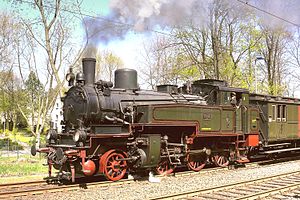- Prussian T 11
-
Prussian T 11
DRG Class 74.0–3
PKP Class OKi 1Number(s): DRG 74 001–358 Quantity: 470 Manufacturer: Union, Borsig Year(s) of manufacture: 1903–1910 Retired: 1974 Wheel arrangement: 2-6-0T Axle arrangement: 1'C n2t Type: Pt 34.16 Gauge: 1,435 mm Length over buffers: 11,190 mm Height: 4,200 mm Overall wheelbase: 6.350 mm Service weight: 62.3 t Adhesive weight: 47.4 t Axle load: 16.0 t Top speed: 80 km/h Indicated Power: 382 kW Driving wheel diameter: 1,500 mm Leading wheel diameter: 1,000 mm Valve gear: Outside Walschaerts (Heusinger) No. of cylinders: 2 Cylinder bore: 480 mm Piston stroke: 630 mm Boiler Overpressure: 12 bar Heating tube length: 4,000 mm Grate area: 1.73 m² Evaporative heating area: 116.40 m² Water capacity: 7.4 m³ Fuel: 2.5 m³ coal Brakes: Knorr compressed-air brake Parking brake: Exter counterweight brake Contents
History
The Prussian Class T 11 were passenger tank locomotives in the service of the Prussian state railways that were intended for duties on the Berlin Stadtbahn. To that end 470 engines of this type were procured between 1903 and 1910. Like the superheated locomotive, the Prussian T 12, the T 11 evolved from the T 9.3 in order to replace the older, four-coupled tank engines. Construction of the T 11 was ceased in 1910 in favour of the more economical T 12.
In 1923, 16 engines were fitted with a superheater, but they retained their existing running numbers.
In 1925, the Deutsche Reichsbahn took over the 358 remaining locomotives as DRG Class 74.0–3, allocating them the numbers 74 001–358.
The locomotives were employed together with the T 12s especially on the Berlin Stadtbahn until its electrification in 1926–1933; as a result they had direction plates (Richtungsschilder) on their smokebox and coal tanks. But they were also used in suburban services for other cities such as Frankfurt, Hamburg and Altona.
At the end of World War II there were still 120 examples of these engines in service, 65 with the Deutsche Bundesbahn and 55 with the Deutsche Reichsbahn (GDR) in East Germany. The majority of T 11s were retired by 1960; but two engines (74 231 und 74 240) continued to work the Erfurt industrial railway until 1974.
Two locomotives have been preserved: 74 104 and 74 231. The former was left in Poland after the Second World War where this class was designated as PKP Class OKi1. The second was restored in 1998/99 in the Meiningen Steam Locomotive Works for the Minden Museum Railway (MEM) and has been working since 2000. It is the former Hannover 7512.
Design
All four axles of the locomotives – even the carrying axles – were more or less equally loaded with a hefty 16 tonnes. The carrying axle was linked to the first coupled axle via a Krauss-Helmholtz bogie. The axles were located in a plate frame, inside which a well tank was rivetted.
The first units had piston valves, the later ones slide valves. The riveted boiler barrel comprised two boiler shells and the smokebox was also rivetted. At the back of the boiler was the copper firebox. Two vacuum Dampfstrahlpumpen served as feed pumps.
For the brakes, there was, next to the smokebox a single-stage air pump, and in front of the carrying axle were one or two air reservoirs.
T 11 of the Lübeck-Büchen Railway
The Lübeck-Büchen Railway also placed nine T 11s in service between 1905 and 1908.
The four engines taken over by Deutsche Reichsbahn in 1938, with numbers 74 361 to 74 364, were however not the Prussian T 11 - that had already been retired or sold off by then - but the LBE's own special designs based that were more like the Prussian T 9.3 and which had been built in 1911/1912 by Linke-Hofmann in a batch of five. The drive resembled that of the T 11, apart from the smaller coupled wheels with a 1,400 mm diameter, whilst the boiler was smaller too. The last of these engines was not retired until 1951.
See also
- Prussian state railways
- List of Prussian locomotives and railcars
Sources
- Jürgen U. Ebel / Hansjürgen Wenzel: Die Baureihe 74, Die Geschichte der preußischen T 11 und T 12, EK-Verlag, Freiburg 1995, ISBN 3-88255-142-9
External links
- Photo of the Polish OKi1 28 (the former DRG 74 104)
- Photo of the Prussian T11 7512 Hannover owned by the Minden Museum Railway (formerly DRG 74 231)
- There is a relevant English-language forum at Railways of Germany
Classes of Prussian locomotive Express train locomotives 
Passenger and express train locomotives Goods train locomotives Tank locomotives T 0 · T 1 · T 2 · T 2/T 4 · T 2.1 · T 2/T 3/T 4 · T 3 · T 4 · T 4.1 · T 4.2 · T 4.3 · T 5.1 · T 5.2 · T 6 · T 7 · T 8 · T 9 Elberfeld · T 9 Langenschwalbach · T 9.1 · T 9.2 · T 9.3 · T 10 · T 11 · T 12 · T 13 Hagans · T 13.1 · T 14 · T 14.1 · T 14 (Exp.) · T 15 · T 16 (Exp.) · T 16 · T 16.1 · T 18 · T 20 · T 26 · T 28Narrow gauge locomotives Electric locomotives to followRailbuses to followCategories:- 2-6-0T locomotives
- Locomotives of Prussia
Wikimedia Foundation. 2010.

